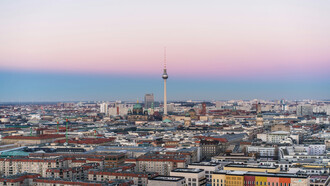Modern cities are fast-paced and densely built, leaving little room for natural retreats. Yet commercial landscape design is proving that even the busiest urban areas can incorporate green spaces that promote relaxation, mental clarity, and well-being.
Healing landscapes, therapy gardens, and biophilic architecture are reshaping urban environments worldwide. These spaces do more than beautify — they enhance physical and emotional health, making city life more balanced.
From rooftop gardens in Bangkok to tree-filled office courtyards in New York, landscape architects are integrating nature into the built environment. Explore how commercial landscapes foster wellness, the benefits of green spaces in cities, and how urban settings can be transformed into thriving oases.
Why is nature important in urban environments?
Nature plays a vital role in supporting the physical, mental, and social well-being of urban populations. As cities become more densely populated, access to green spaces is increasingly limited. This can lead to elevated stress levels, reduced air quality, and a decline in overall health.
Exposure to nature can significantly lower cortisol levels — the hormone associated with stress — and improve cognitive function, helping people feel more relaxed and focused. Green spaces also promote physical activity by encouraging walking, cycling, and outdoor recreation. Additionally, trees and vegetation act as natural air filters, improving air quality and reducing respiratory-related health issues.
Beyond individual health benefits, integrating nature into urban environments fosters stronger communities and social bonds. Parks, gardens, and green rooftops offer gathering spaces where people can connect, reducing feelings of isolation and promoting a sense of belonging.
Interestingly, neighborhoods with more greenery tend to experience lower crime rates and greater community engagement, as well-maintained natural spaces create a welcoming atmosphere that encourages positive social interaction. Urban landscape design also has tangible economic benefits. Well-designed landscaping boosts curb appeal and increases property values, attracting businesses, residents, and visitors. From an environmental standpoint, urban greenery helps regulate temperature by mitigating the heat island effect — a phenomenon where concrete and asphalt absorb and retain heat, causing dangerously high temperatures. Trees provide shade and reduce energy consumption by cooling buildings. They also help manage stormwater runoff by absorbing rainwater and reducing the risk of flooding.
Transforming urban settings into oases
Creating green urban spaces requires strategic planning and innovative design approaches. Key strategies include:
Biophilic architecture: Incorporating natural elements, such as living walls and rooftop gardens, into buildings.
Therapy gardens: Designing healing landscapes that support stress relief and physical rehabilitation.
Green infrastructure: Using tree-lined streets, vertical gardens, and water-efficient landscaping.
Public accessibility: Ensuring green spaces are open, safe, and accessible to diverse communities.
Elements that contribute to a healing landscape
Healing landscapes are specifically designed to encourage restoration and relaxation. Common elements include:
Multisensory plants: Fragrant flowers, textured foliage, and seasonal color changes stimulate the senses.
Water features: Fountains, ponds, and rain gardens create soothing sounds and improve air quality.
Shaded seating areas: Benches, pergolas, and tree canopies offer comfortable places to rest.
Natural light integration: Open spaces that maximize sunlight exposure help regulate mood and sleep cycles.
Real-life examples: green spaces that promote healing and wellness
Cities worldwide are embracing green spaces to improve public health and well-being. From hospitals with therapy gardens to parks designed for relaxation, these spaces provide measurable mental and physical health benefits. Below are real-life examples of commercial and public landscapes that support healing and wellness:
Maggie’s Centre, Scotland: healing gardens for cancer patients
Maggie’s Centres — a network of cancer support facilities across the U.K. — incorporate healing gardens as a core element of their design. The Maggie’s Centre in Dundee, Scotland, was designed by architect Frank Gehry and features a garden by renowned landscape designer Arabella Lennox-Boyd. These gardens offer a serene environment where patients and families can find comfort, process emotions, and benefit from nature’s therapeutic qualities.
Singapore’s gardens by the bay: a city-wide biophilic approach
Singapore has long prioritized urban greenery, but Gardens by the Bay takes this commitment to a new level. This 101-hectare nature park features futuristic Supertrees that collect rainwater and generate solar energy. The park merges technology and nature, demonstrating how large-scale green spaces can benefit both the environment and public health.
The High Line, New York City: transforming infrastructure into a green oasis
Once an abandoned railway, the High Line is now one of New York City’s most iconic green spaces. This elevated park runs through Manhattan and includes native plants, public art installations, and seating areas designed for relaxation. By increasing access to green space, the High Line promotes physical activity and improves community well-being.
Building greener, healthier cities
Urban landscapes are evolving to meet the growing need for green spaces. By integrating biophilic design, healing landscapes, and sustainable infrastructure, architects and urban planners can create healthier, more livable cities. Whether through rooftop gardens, therapy landscapes, or biodiversity-focused initiatives, these efforts show that cities don’t have to be concrete jungles — they can become thriving, restorative oases for people and nature alike.
Notes
6 Reasons Why Four-Season Sunrooms Are Worth It.
Is the spatial distribution of urban green space associated with crime in Chicago?.
Best Time of the Year for Landscaping.
6 amazing Maggie’s Centres showcasing the healing power of design.
An analysis of the effects of different urban park space environment construction on national health.














